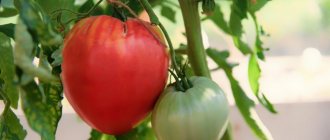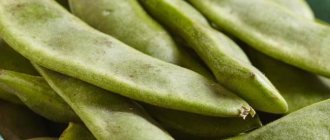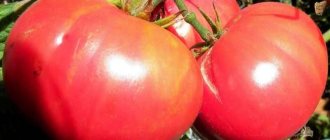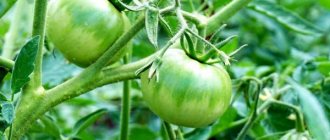Description of the variety
Tomato Pineapple is disease resistant and easy to care for. It belongs to the tall varieties; the height of the bush during the growing season reaches 2 m.
It is recommended to form the variety into 3 stems. The first inflorescences appear on the bushes near the 8-9 leaves. From 5 to 6 fruits ripen on one cluster.
There are several types of Pineapple tomato:
- Taiwanese.
- Yellow.
- Hawaiian.
- BIO.
- Steak.
- Black, etc.
Distinctive features
The varieties differ in the color of the fruit. Many of them have not only a pleasant taste, but also an unusual color. For example, Black Pineapple has a brown color with green stripes, but the flesh of a tomato is completely green.
But the Pineapple Beefsteak variety is bright orange, and when cut, it turns from orange to yellow towards the edges. Another difference between Pineapple and other varieties is the high sugar content in the fruit; tomatoes have notes of citrus.
Fruit characteristics and yield
The fruits of the Pineapple variety are quite large, the weight of one reaches 900 g, the average weight is about 250 g. The tomatoes are sweetish with a citrus taste and fruity notes.
By the end of the harvest season, the taste of the tomato becomes even more intense. The fruit has dense pulp and a small number of seed chambers. The vegetables are strong, do not crack, and can withstand transportation over long distances without losing their presentation.
One bush grows up to 40 clusters , each with about 5-6 fruits. With an average weight during the fruiting period, the bush produces at least 30 kg. If you artificially stop growth, you can increase yield without losing taste.
Pros and cons of the variety
The disadvantages and advantages of the Pineapple tomato are due to the indeterminate nature of this variety. There are very few disadvantages. The main one is the impossibility of growing these tomatoes outdoors in areas where the summer period is short. Other cons :
- longer development of the vegetative part than that of determinants;
- Fruit ripening occurs later than in varieties with limited growth;
- the large size of the fruit makes whole-fruit preservation impossible;
- the need for mandatory tying of bushes.
Advantages of this variety:
- multiple births and high productivity;
- greenhouse plantings can be renewed less frequently due to their long life span;
- Generative buds are constantly formed and new fruits are laid accordingly;
- Pineapple is easy to shape;
- tomatoes can be grown in open and closed soils;
- the extended fruiting period makes it possible to collect fresh tomatoes for a long time, in warm regions until September;
- tall and small-diameter bushes are rational for greenhouse and greenhouse areas;
- well stored, does not crack;
- transportable;
- has a good presentation.
Some consider the unusual appearance of the Pineapple tomato to be an advantage, others to consider it a disadvantage, but this depends on everyone’s personal taste preferences.
Other interesting tomato varieties:
How to grow seedlings?
Tomatoes are delicious and beloved vegetables by many. They come in different sizes, large and small, meaty and juicy. And most importantly, they are easy to grow.
To grow seedlings you need:
- Prepare the seeds.
- Select a container and prepare the soil.
- Sow change.
- Grow seedlings.
- Provide her with proper care.
Let's consider each of the points separately.
Seed preparation
So that your efforts when planting seeds are not in vain, you need to carefully sort them out. To speed up the sifting process, place them in a container of salt water.
Water is diluted as follows: 1 tablespoon per glass of water. After 10 minutes, bad seeds will float, and good ones will fall to the bottom.
After selecting the seeds, they need to be prepared for planting.:
- Disinfection protects the plant from diseases. For this:
- The seeds should be left in a 0.8% solution of vinegar or for a third of an hour in a weak solution of manganese.
- After the procedure, carefully rinse the seeds with running water and dry.
- Warming up the seeds This is done if they have been in a cold place for a long time. Warm them up as follows:
- Or leave it near the battery for 2-3 days.
- Or for several hours in a thermos with hot water. After this it is dried.
- Hardening helps young shoots adapt to different environmental conditions.
- Take a piece of cloth, place the seeds on one half, cover the other half on top, place it on a saucer, pour in a little water and leave it in the room for one day.
- On the second day, place the plate with seeds on the bottom shelf of the refrigerator for 24 hours.
- Repeat the procedure a day later.
All these procedures are needed to prepare the future plant for various environmental changes and improve productivity.
Attention ! After the seeds are prepared, they must be planted immediately. That is why, while the seeds are being prepared, prepare the planting site.
Container and soil
Before planting seeds, you need to prepare the soil and container for planting. Choose a large container to plant all the seeds at once.
When the tomatoes sprout, they are already seated in separate cups.
The soil for planting tomatoes should consist of three parts:
- turf;
- humus;
- sand.
If for some reason you do not have the opportunity to prepare the mixture yourself, then you can purchase it at a specialized store. Seeds are planted 1.5-2 months before transplanting seedlings to a garden bed or greenhouse.
If you do this ahead of schedule, the sprouts will not have time to grow stronger and will die. And if you delay this process, they will stretch out and replanting will be inconvenient.
Sowing:
- Pour the soil mixture into the prepared container and lightly compact it.
- We water the finished soil and cover it with film overnight.
- The next day, the soil must be leveled and grooves made for sowing at a distance of about 4 cm from each other, the depth of the hole is 1 cm.
- Pour the seeds evenly into the prepared holes, sprinkle them with soil and water them.
- Cover the container with film and place it on the window.
- After a week, the film must be removed and the container moved to a room where the temperature is up to +16 degrees.
- After another week, the container with seedlings must be returned to the windowsill and the sprouts should be provided with a temperature regime of up to +24 during the day and up to +12 degrees at night.
Cultivation and care
The main thing in caring for tomatoes is to properly provide and maintain certain environmental factors at the required level. Such as:
- humidity;
- temperature;
- Fresh air;
- lighting.
Let's look at all the factors and necessary conditions in more detail:
- Watering. Until the seeds sprout their first shoots, soil moisture must be checked every day. If the soil is dry, moisten it with a spray bottle.
Important ! Never water the soil with seeds without a special device, otherwise you may wash the seeds out of the soil.
Water with warm water, second watering after a week. But monitor the soil moisture every day. If it dries out, the sprout will die. The plant is watered with a pipette at the root, without getting on the leaves.
- Lighting . For seedlings, choose the brightest place in the room. Most often this is a window sill. In addition to natural light, the plant will also need artificial light, which can be organized using a lamp. The plant must be illuminated at least 14 hours a day.
- Temperature . For the sprouts to sprout, the room temperature must be from +25 to +28 degrees. After a week, the temperature can be lowered to +20-25 degrees. And in another two weeks - up to room temperature.
- Ventilation and humidity . While the seeds are under the film, the container should be lifted and moisture removed so that mold does not appear due to excess moisture. If mold does appear, remove the affected soil and water the soil with a solution of potassium permanganate. The film can be removed only after 1-2 weeks after shoots To prevent this from causing injury to the plant, the film should be opened briefly every day.
- Fertilizer. After the first sprouts have appeared, at least 10-14 days must pass before the first complementary feeding. After this, the plant is fertilized every week. Fertilizers are introduced when the sprouts produce their first leaves with teeth. After the tomato sprouts produce their first true leaves, they need to be pruned.
Reference ! Picking is the procedure of transplanting a plant from a common container into an individual pot or glass no smaller than 10x10 in size.
During the picking process, all sick and weak plants are eliminated. When picking, the seedlings are transplanted deeply, the stem is buried right up to the leaves.
Description of tomato Black pineapple
The Black Pineapple tomato is a very interesting variety, as it has a dark-colored peel. Many vegetable growers have long turned their attention to it and even began to intensively cultivate it. The Black Pineapple tomato variety has the ability to grow only in a greenhouse.
Description of tomato Black pineapple
Description of tomatoes
The Black Pineapple tomato was born in Belgium. It has a sweet citrus taste and a tri-color color. Tomatoes are added to salads, eaten fresh and canned for the winter. Their pulp is sugary, and there are practically no seeds. The color of tomatoes is always different, it is impossible to guess what colors will be this season. They can be painted green, olive, yellow, black, red, burgundy and orange, and this color is not only outside, but also inside.
The shape of Black tomatoes is round-flat with small ribbing. The fruits are quite large, one weighs 700 grams. The description of Black Pineapple is different, it all depends on the growing conditions. Tomatoes grow well in a greenhouse, the bush is 180 cm tall, and the fruits are mid-season. Tomatoes are formed into several bushes, the harvest is rich and beautiful. Basically, when the seeds are sown for the first time, the fruits grow large.
The Black Pineapple tomato variety ripens within 120-130 days. From one bush you can get 8 kg of harvest. The Black Pineapple tomato variety has a wonderful taste and interesting color. It is preferred by many gardeners, who are always delighted. In addition, there are other varieties of tomatoes that have the same qualities and characteristics:
- Davida Chernaya;
- Hawaiian tomato;
- golden tomato;
- Zebra variety.
Preparing the soil for planting
An important point for planting is the acidity of the soil. Many tomatoes prefer light soil and Black Pineapple does the same. If the acidity of the soil is very high, then it will have to be limed every 3-5 years. It is forbidden to plant tomatoes in the place where eggplants or peppers previously grew. An area where cucumbers, carrots, onions or cabbage have recently grown is perfect for them.
Humus or peat must be added to the soil. It also needs to be mixed with superphosphate and wood ash. To prevent vegetables from getting sick while growing, before mixing all the fertilizers in the soil, it is frozen for a while. In order for tomatoes to grow and develop calmly, they need the addition of substrates, for example, the following:
- peat 7 parts;
- 1 part sawdust;
- 1 part wood ash;
- 3 batches of peat;
- 1 batch of humus;
- 0.5 sawdust and manure.
How to sow seeds and care for seedlings?
After a month, the seedlings can be planted in the greenhouse
An excellent harvest is obtained if seedlings are grown correctly. First you need to check the tomato seeds for germination, so they are placed in salt water for 10 minutes. Those seeds that have sunk should be thrown away, and the remaining ones should be washed under running water. The tomato seeds are transferred to a towel and allowed to dry a little. The next day they begin to be planted in special pots for seedlings.
Holes are made in the pots so that excess moisture can escape and oxygen can reach the roots. The soil for planting must be prepared in advance and poured into pots. The seeds are buried to a depth of 1 cm and then watered well. After 20 days, the seeds will begin to sprout the first stems, and after 45 days the stems will begin to grow stronger. In addition, the seedlings are watered 3 times a day and sometimes placed in a sunny place.
Solar procedures will prevent the seedlings from starting to rot. It is also necessary to ventilate the room where the plant is located from time to time. After a month, the sprouts can be transplanted into the greenhouse. 7 days before transplantation, the plant is sprayed with boric acid, 1 g per 1 liter. This is necessary to get a good and high-quality harvest.
Planting tomatoes in a greenhouse
To begin with, add 2 handfuls of humus to the holes. Remember that you cannot throw in fresh fertilizers, such as humus or manure, as this will kill the vegetables. In a hole with seedlings you can put 25 g of simple superphosphate, or 15 g of double superphosphate. Fertilizers in the form of nitrogen and potassium are not added. Nitrogen can cause greens and weeds to appear, which will only slow down the plant's growth.
Black Pineapple Care
In order for tomatoes to feel great in the greenhouse and to grow properly, they need to be pruned. Excess leaves and unnecessary shoots are removed as they interfere with normal growth. But this should be done very carefully so as not to accidentally pull out anything unnecessary. First, the leaf itself begins to grow, and only then the stepson. It is located between the leaf and peduncle. The stepson gardener should remove it to speed up ripening.
If you do not prune and leave everything as it is, the bushes will become very overgrown and produce green fruits. Trimming is carried out from the first cluster, which immediately begins to bloom. To get a good harvest, leave from 2 to 5 brushes. If you leave 2 bunches, the tomatoes will grow simply giants, and if you leave 5, then they will grow small. The person who grows tomatoes decides for himself what size fruit he needs.
Black Tomato Diseases
To prevent tomatoes from being eaten by parasites, it is necessary to carry out preventive measures. The most common diseases that affect tomatoes are presented below.
- Blackleg disease infects the stem of a plant, causing it to darken and thin. The disease appears due to a large amount of moisture in the ground and air. To prevent it, it is necessary to ventilate the greenhouse and take care of the light.
- Another popular disease is blossom end rot. It can appear from a lack of water in the ground and in the air. Brown spots appear at the top of the bush, which over time attack the entire bush from top to roots. To prevent disease, water the soil properly and provide ventilation.
- Streak disease is a virus that affects many plants, including tomatoes. To recognize the disease, you don’t need to make a lot of effort: brown stripes appear on the peduncles, and dark spots are sprinkled on the leaves. The plant will eventually die, since the streakiness is quite difficult to remove. But there is one method; to do this, the plant is disinfected in a 1% solution of potassium permanganate.
- The last most common disease is fruit rot. It appears due to pathogens during ripening. Rot spreads to all fruits quite quickly. It all depends on temperature and humidity. To prevent it from appearing, it is necessary to frequently ventilate the greenhouse and maintain the correct temperature.
Summarize
Planting and growing Black Pineapple tomatoes is not difficult. Any gardener can do this. The main thing is to fulfill all the requirements and monitor the appearance of diseases on the plant. Tomatoes of this variety have a wonderful sweet taste that can be compared with any fruit. Those who have already grown this variety were satisfied.
How to grow tomatoes
Before planting seedlings in a garden bed or greenhouse, they need to be hardened off . To do this, it is enough to leave the windows open at night.
Landing
Tomatoes are planted in open ground at the end of May or beginning of June, when they are no longer threatened by frost. By this time, the plant already has a strong stem and at least 5 leaves.
Before transplanting tomatoes you need to prepare the soil:
- Rake the ground.
- Make holes at a distance of 30 cm.
- Fertilize each hole with 1 tablespoon of superphosphate.
- Water each hole.
When the soil is ready for replanting, it is necessary:
- Stick a peg next to each hole, which will become a support for the bush.
- Before planting, water the hole again and plant the sprout along with soil from a cup.
- Next, the plant is lightly compacted with earth and watered.
Care
After the plant has been transplanted into a garden bed or greenhouse, it must be cared for as carefully as seedlings on a windowsill.
Basic procedures:
- Loosening . During the first time after replanting the plant, it is necessary to monitor the condition of the soil and prevent it from cracking. When the plant takes root and gets stronger, the soil can be loosened once every 4 days.
- Watering . When watering, water should not fall on the plant. While the tomato bush is growing, the frequency of watering is increased, and when the first fruits appear, it is reduced. Tomatoes are watered with relatively warm water; cold water can chill the roots, which will lead to the death of the plant.
- Feeding . Two weeks after transplantation, the tomato must be fed with a mixture of: saltpeter, urea, superphosphate and potassium salt. Three weeks later, the procedure is repeated.
- Weeding is carried out every 14 days in parallel with loosening. You need to weed the bed manually. Removing weeds promotes good plant growth and productivity.
- Planting a plant is one of the important activities that must be carried out at all stages of development. Pinching is the removal of side shoots from a plant. This can be done using pruning shears or manually. It is advisable to do this before the shoot grows to 5 cm, then it will injure your plant less. Before you start removing unwanted shoots, decide how many stems you want to grow the bush. If it is 2-3, then the growth of young shoots must be stopped in time.
- Bush formation . One of the main questions when growing the Pineapple variety is how many stems to grow. Tall varieties, which include the Pineapple tomato, grow in one stem. To do this, we form a bush using the pinching method already known to us. When choosing a method for forming a bush, also do not forget about such an important factor as climatic conditions.
- Gartering tomatoes is a must. Pineapple is a tall variety and has delicate and weak stems that can break under its own weight or under the weight of ripening varieties. A tied plant is easier to water and loosen. Tomato garter also protects its fruits from pests and various diseases.
With proper care, the plant will delight you not only with stable growth and development, but with excellent productivity.
Features of cultivation and care
In March-April, the seeds are soaked in gauze or cotton wool, after treatment with a solution of potassium permanganate and a growth stimulant, they are planted in containers with a substrate consisting of:
- soil from the garden;
- peat;
- river sand (washed);
- wood ash.
You can buy ready-made soil at gardening stores. Make grooves 1 cm deep in the soil, place seeds and sprinkle.
Before the loops appear, mini-greenhouses are covered with glass or film, the average temperature before germination is 25-27 ° C, after germination it must be lowered by 7 degrees. The container is placed in a lighted place.
Seedlings are planted after the end of spring frosts . Planting density is 2-3 plants per square meter. The optimal predecessors of this hybrid are zucchini, cucumbers and carrots. Any nightshade (potatoes, sweet peppers, etc.) are undesirable.
Water the Pineapple once a week. Growing bushes are tied to separate pegs, but it is more convenient to place trellises on the beds or in the greenhouse. Loosening and fertilizing are carried out periodically, the latter is especially important when setting and forming fruits.
Features of cultivation and possible difficulties
The Pineapple tomato is a mid-season variety: to get an earlier harvest, the seeds need to be planted at the end of March or beginning of April.
About 7 days before planting the Pineapple tomato, you need to start hardening the plant . To do this, they are taken out into the fresh air. Every day, the time spent in the open air is increased; on days 3-4, they are left in the air overnight.
Attention ! Avoid direct sunlight on the leaves, otherwise they may burn.
When planting a tomato in open ground, do not forget that the plant is tall and there should not be more than 2-3 bushes per square meter.
You should water the tomatoes carefully and moderately, otherwise fungus may not only develop in the soil, but the roots will also begin to rot. Plants are fertilized once every two weeks. If you properly care for your tomatoes, they will delight you with a bountiful harvest until autumn.
Difficulties in growing tomatoes can arise in a variety of ways.:
- Seedlings that grow on a windowsill become pampered under favorable conditions and will not easily adapt when transplanted. To avoid this, harden off the seedlings.
- The leaves of seedlings turn yellow and dry out - these are the consequences of a lack of light or excess moisture.
- The plants do not have enough light due to the plants being planted too close, and they begin to stretch towards the light.
- If the leaves are limp and drooping, the plant does not have enough moisture.
- If white spots appear on the leaves of a tomato, they are sunburned, but brown spots indicate a fungal disease.
To overcome all these difficulties, it is enough to carefully examine the plants and follow the basic rules of caring for them.
Diseases and pests
Diseases and pests affect growth and yield . There are several problems that can be identified by appearance. All diseases, except fungal ones, can be prevented or cured by feeding the plant with one fertilizer or another.
But the spread of mold on a plant threatens you with the loss of the entire bush and infection of neighboring ones. This happens because the fungus spreads quickly.
But there are several more dangerous diseases and pests that you need to know about.:
- Blooming rot on the back of the fruit . It is easy to recognize: a dark-colored spot the size of a two-ruble coin appears on the back of the fruit. You can get rid of the disease by removing the affected fruits. To prevent a recurrence of the disease, you need to monitor watering and fertilize the plant with calcium (some gardeners use crushed eggshells as a top dressing).
- The flowers begin to set, but fall off and the fruit either does not have time to develop at all or is very poorly developed. This often happens due to sudden changes in the weather, for example: during the day the temperature was above 35 degrees, and at night it dropped to 10. Mulching will help to avoid the problem.
- Sticky and deformed leaves . The cause is the pear-shaped aphid. It causes damage to the plant by sucking the juice out of it and leaving behind a sticky substance on the leaves and fruits. In addition to aphids, whiteflies and spider mites can cause the same visible symptoms. Special insecticidal sprays and removing weeds around the plant will help get rid of pests.
- Cracking of fruit skin . Cracks may appear due to accelerated growth caused by increased humidity, for example: rain after a long drought. Another reason may be banal overripeness of the fetus.
- Formation of black-brown spots on leaves . The cause of these symptoms is a fungus that survived on old plants and transferred to new ones. To cure the plant, you will need to purchase special aerosols and remove all old plants from your garden.
- Nematodes . The bad news is that the plant cannot be cured of this scourge. Good - despite this, the plant is capable of producing edible fruits. To prevent new plants from getting sick, plant marigolds next to the garden bed; they release chemicals that kill nematodes.
Attention ! Under no circumstances should such plants be left in the garden or placed in a compost pit. Otherwise, infection of healthy plants cannot be avoided. It is best to burn old plants or remove them from the site.
Growing and care
Gardeners recommend starting seed preparation in March-April. First of all, they need to be disinfected: this will require a weak solution of potassium permanganate or hydrogen peroxide. The seeds should be kept in this composition for at least 12 hours. After this, they should be treated with a growth stimulator and soaked in gauze or cotton wool. It is important to ensure that the fabric does not dry out.
After this, you can plant the seeds in a container with a previously prepared substrate. The best soil is a combination of wood ash, garden soil, washed river sand and peat. Before sowing planting material, the soil should also be disinfected: experienced gardeners advise calcining it in the oven at a temperature that does not exceed 100 degrees, or spilling it with a weak solution of potassium permanganate. In containers with soil, grooves should be made, the depth of which should not be more than a centimeter. Seeds should be placed in them, sprinkled with soil, and moistened. Immediately after this, the mini-greenhouses must be covered with film or glass. Before emergence, it is necessary to maintain the temperature at +25. +27 °C. When the first shoots appear, it is recommended to lower the temperature by 7 degrees and move the container to a well-lit place.
As soon as the last spring frosts have passed and stable warm weather has established, you can plant the “pineapple” in a permanent place. You should not place more than two or three plants on one square meter. It is best if zucchini, carrots or cucumbers grew on the soil before. But any nightshades, including sweet peppers or potatoes, are undesirable as predecessors. Tomatoes must be planted in pre-prepared holes, into which a small amount of fertilizer must first be added. Immediately after transplanting the seedlings to a permanent place, the soil should be moistened and mulched. Pineapple tomatoes should be watered once a week. It is necessary to carry out procedures such as loosening, pinching, tying and fertilizing in a timely manner. It is best to use the fertilizer three times per season: two weeks after planting the seedlings in the ground, during the flowering of the bushes and during the formation of fruits.
The nuances of breeding in open ground and in a greenhouse
When growing any plant there are certain nuances that must be taken into account.
The nuances of growing Pineapple tomatoes in open ground and in a greenhouse:
- Wrong choice of landing site . Choose a sunny area where nightshades have not been planted before.
- Growing different crops together . For example: cucumbers and tomatoes cannot be planted in the same greenhouse, since they need completely different climatic conditions.
- Incorrect formation of tomatoes . Sometimes gardeners feel sorry for removing side shoots, or they forget to pinch the tops in time. The bush grows lush and weighty, but, unfortunately, does not bear fruit. A plant that is planted in open ground should not have more than 4 stems.
- Stem constriction . When gartering tomatoes, you need to be extremely careful not to damage the stem.
- Late stepsoning . If the side shoots are not removed in time, the yield will suffer. They need to be removed at a size of 3-4 cm, since they consume all the nutrients and do not allow the plant to develop.
- Eating disorder . Sometimes gardeners get carried away with feeding the plant and, instead of a large harvest, end up with a lush bush with large, strong leaves. This is due to the large amount of manure.
- Closed greenhouse . If the greenhouse has high humidity and temperature, it should not be closed. In tomatoes, pollen grains stick together and normal pollination does not occur, which means the plant bears fruit worse.
- Late processing . Tomatoes growing in a greenhouse should be treated with biological products once every two weeks or after each harvest.
Advantages and disadvantages of the variety
The variety got its name not only because of its appearance, but also for its taste.
The main advantages of tomato include:
- the appearance and taste of the tomato resembles pineapple and citrus fruits;
- suitable for both fresh consumption and winter preparations;
- high yield rates;
- easy care.
The main disadvantage of the variety is frequent pinching, which will take more time when caring for the plant. There is also a small drawback - large fruits must be eaten immediately; they are not suitable for pickling.
Productivity
Tomatoes of the Pineapple variety are harvested after the fruits have fully ripened. The plant is a mid-ripening variety, so the risk of fruits not ripening before the end of the growing season is minimized.
Tomato variety Pineapple is consumed:
- fresh;
- in salads;
- first and second courses.
Tomatoes are also well suited for whole-fruit canning.
Fruit harvesting begins when the tomatoes reach the so-called blanche ripeness - at this time the yellow color of the tomatoes becomes saturated, beginning to turn into brownish shades. At this moment, the taste of tomatoes becomes most vivid.
Did you know? Tomatoes are rich in vitamin C, but its concentration decreases significantly during long-term storage.
The yield of a bush can be up to 30 kg of fruit per season, since up to 40 clusters are formed on each plant. The plant begins to bear fruit on average 4 months after germination and does so until the beginning of autumn in warm regions when grown in open ground.
Tomatoes are used mainly for fresh consumption and for making salads.
This variety is widely used by many summer residents. It is considered indeterminate and grows to a height of more than 2 meters, which causes significant inconvenience. Due to a significant increase in growth, the fruits require constant care, tying, picking and creating bushes. The basis for choosing a pineapple variety is its high yield and distinctive resistance to major diseases.
With proper care, the fruit grows up to 0.7 kilograms.
Varieties Black, Gold, Hawaiian and Beefsteak
Pineapple tomatoes have several varieties:
- Black pineapple comes from Belgium. The fruit is colored in three colors: yellow, burgundy and orange. Despite its excellent taste, it is not suitable for winter preparations. The weight of one reaches 700 g.
- The golden pineapple has a golden color with a pink cap. It also has excellent taste. Suitable for eating raw and for preparations. Fruit weight 200-600 g.
- Hawaiian pineapple is orange in color, the fruits are large, the weight of one can reach 700 g.
- Tomato Beefsteak pineapple , one fruit weighs about 300 g. It has a bright red color.
All of them are approximately similar in their taste, resistant to diseases and pests.
History and characteristics of the variety
This two-color tomato variety appeared thanks to the efforts of American breeders and was called Bi-color Pineapple Tomato. A special feature of this crop is its attractive, juicy and bright yellow color on the outside, while the pulp in the middle of the fruit has a richer orange color and smoothly turns yellow towards the edge. This tomato variety has gained popularity due to its interesting taste with sweet notes, which is why it got its name.
Did you know? The yellow color of Pineapple tomatoes indicates that they contain a large amount of vitamin A - a source of carotene, which promotes good skin condition, removes toxins and improves vision.
Gardeners fell in love with the variety for its long-term fruiting. Pineapple tomatoes are often used fresh for preparing salads and seasonal vegetable platters. The variety can be processed for the preparation of sauces and adjika; it is rarely used for preservation, since the fruits are large in size. Tomatoes are grown in southern regions with a lot of sunny and warm days, in open ground, and in cooler regions - in high greenhouses.
The variety is mid-season, indeterminate, ripening within 120–130 days. The bushes reach 1.5–2 m and are tall. The bush is formed into 3 stems. The first inflorescence is formed above the 8–9 leaves, each cluster of the bush has 5–6 tomatoes. Pineapple fruits are very large, can reach 900 g, but the average weight of tomatoes is 250–300 g. The taste is sweet, with a slight hint of citrus and fruity notes.
The aroma and taste of tomatoes improve towards the end of the season. The pulp has a dense structure, with a small number of seed chambers. The color of the pulp has two colors: a more saturated orange color in the center of the fruit, changing to a lighter, yellow color towards the edges. The variety is resistant to most tomato diseases.
Important! The appearance of the ripe fruit resembles the fruit of the same name, since the tomato skin has light yellow ribs reminiscent of pineapple scales.
It should also be said that the series of tomatoes with an unusual flesh color of two or three colors also includes the following varieties:
- Hawaiian pineapple is a large orange fruit with a pronounced pineapple flavor, sweet, weighing up to 700 g.
- Golden pineapple - yellow fruits with orange stripes in cross-section have an orange color with pink veins, are sweet, the taste is similar to pineapple. The average fruit size is 300–400 g, and can reach 1 kg.
- Black pineapple is a variety of Belgian selection; the fruits have a citrus taste and a tricolor color. The tomatoes are sweet, practically without seeds, round and slightly flattened, with ribs, average weight - 700 g. The color of tomatoes is always different and can be green, olive, black, yellow, red, orange and burgundy. The tricolor color is preserved inside the fruit.
Advantages and disadvantages
- The variety has a large number of positive characteristics, which include:
- early and mid-early ripening;
- long fruiting (in warm regions the fruiting season can last until September);
- good yield;
- attractive appearance of tomatoes;
- interesting, sweet taste, which becomes more pronounced towards the end of the season;
- large fruit size;
- good transportability (does not crack when transported over long distances);
- does not require much effort during the growing process, unpretentious to the conditions;
- can be grown in open ground and high greenhouses;
- has an attractive presentation.
Pineapple tomatoes are often used in children's and diet menus. Experts and experienced gardeners agree that the variety has virtually no negative characteristics. However, tomato bushes require mandatory pinching and staking.
Photo
Below you can see photos of varieties of Pineapple tomatoes.
Black:
Gold:
Steak:
Hawaiian:
Farmer reviews
Reviews left by farmers after growing and eating Pineapple tomatoes:
- Victor, Taganrog : “A good variety that ripens earlier than others. Does not require special care, everything is according to the standard scheme, watering, feeding, etc. The only drawback is that the bushes need to be tied up, otherwise they break or fall.”
- Valeria, Volgograd : “I recommend the Pineapple tomato variety to those who sell vegetables or like to eat them. The vegetables grow well and don’t get sick, but our family didn’t need their high yield, since we can’t eat a lot, and I don’t use them for pickling because of the color. Therefore, one bag of seeds is enough for one bed.”
- Sergey, Ivanovo : “The variety is good, but those who have not planted it before will have to get used to the different taste qualities. And so there are no more complaints. The yield is high, it bears fruit all summer, just have time to collect. The main thing is not to forget to pick and tie up the bushes in time, as they grow very wildly. If planted in a greenhouse, the bush can grow up to 2 m.”
Pineapple tomatoes are an unpretentious plant that will not cause you much trouble, positive in terms of cultivation, yield and consumption. It can be planted both in open ground and in a greenhouse. Bush formation and pinching are required.
Reviews
Speaking about this variety of tomato, gardeners note: the yield will be higher if you feed not only adult bushes, but also seedlings. A complex fertilizer for seedlings of tomatoes and peppers is suitable for this. The variety is quite unpretentious and does not require any special care. The only peculiarity is the need to tie up the bushes. Otherwise, they will either break or lie on the ground, which will lead to rotting of the fruit. The most convenient way, gardeners say, is to use trellises.
The tomato is not afraid of the main diseases of the nightshade family and pest attacks. Summer residents recommend planting the pineapple variety on their plots to those who either consume tomatoes in large quantities or sell them. The fact is that the yield of the variety is very high: it will not be possible to preserve them, and there are too many of them for homemade salads and tomato paste.
Source











